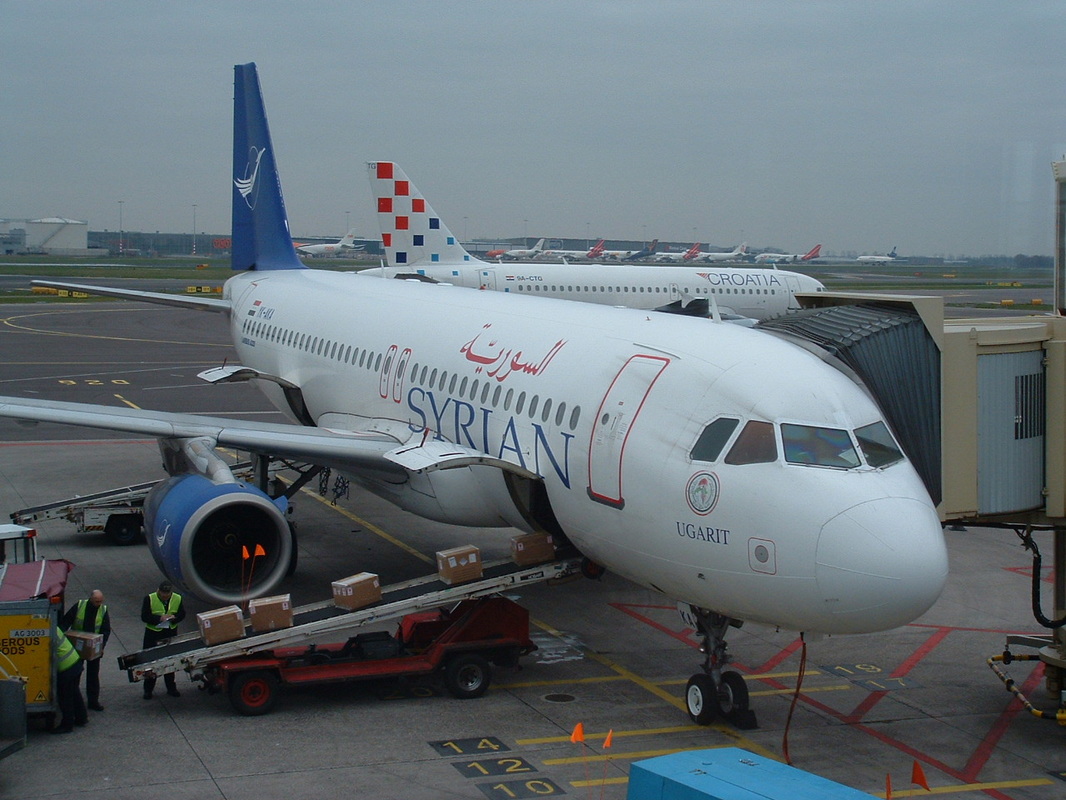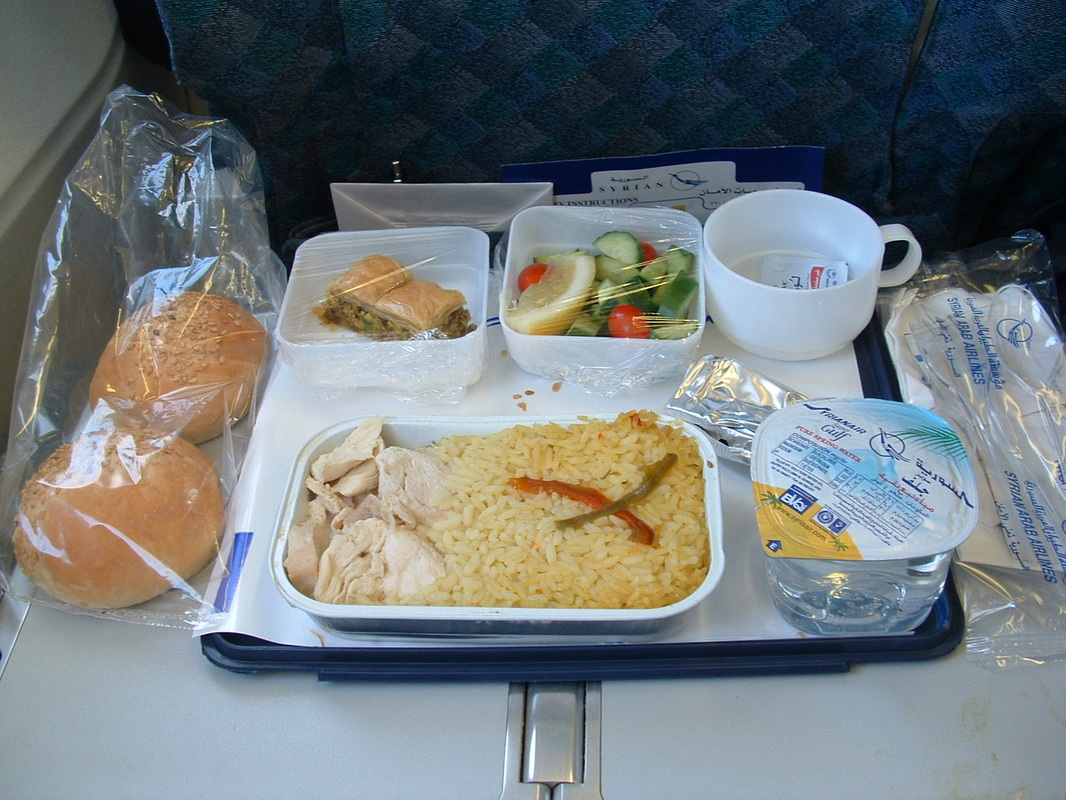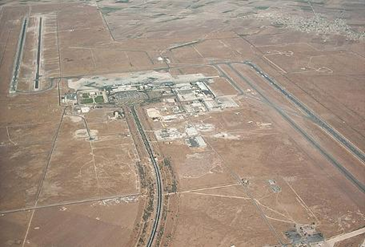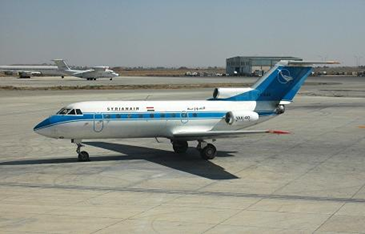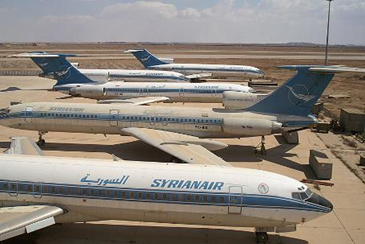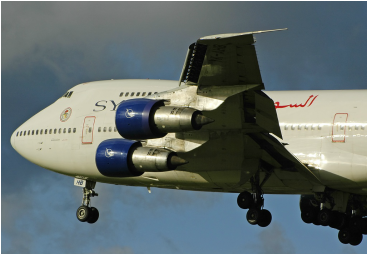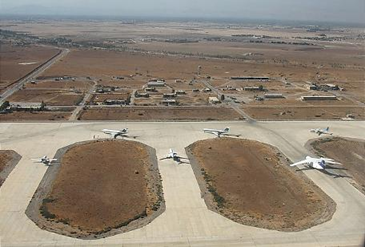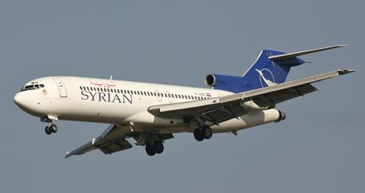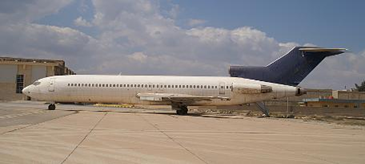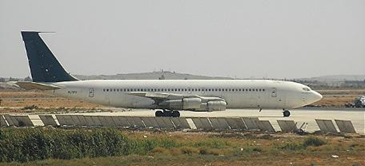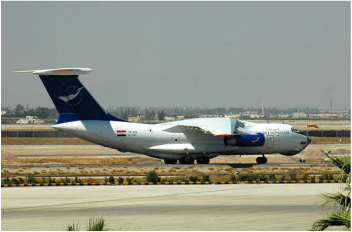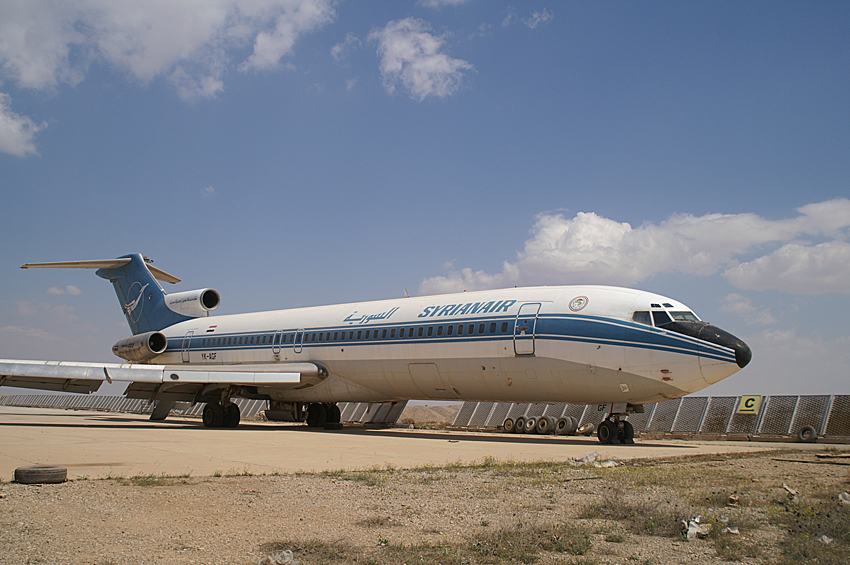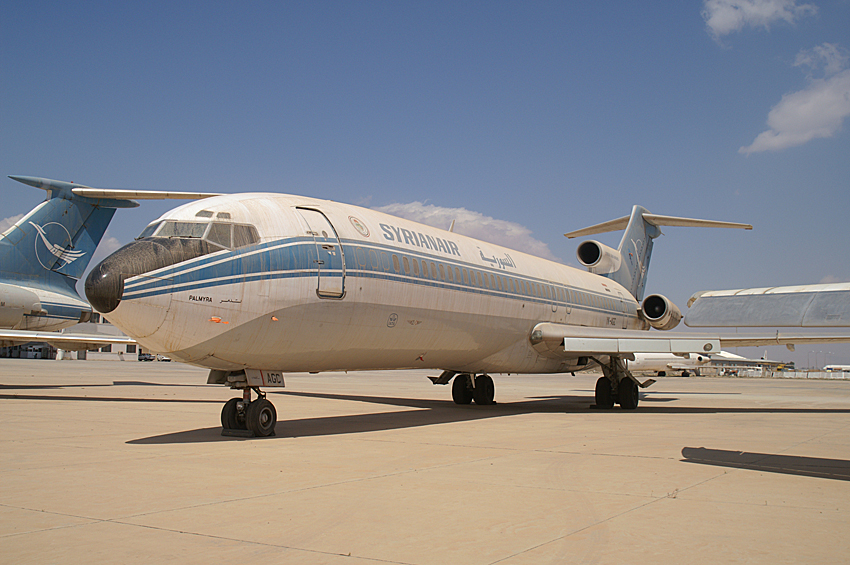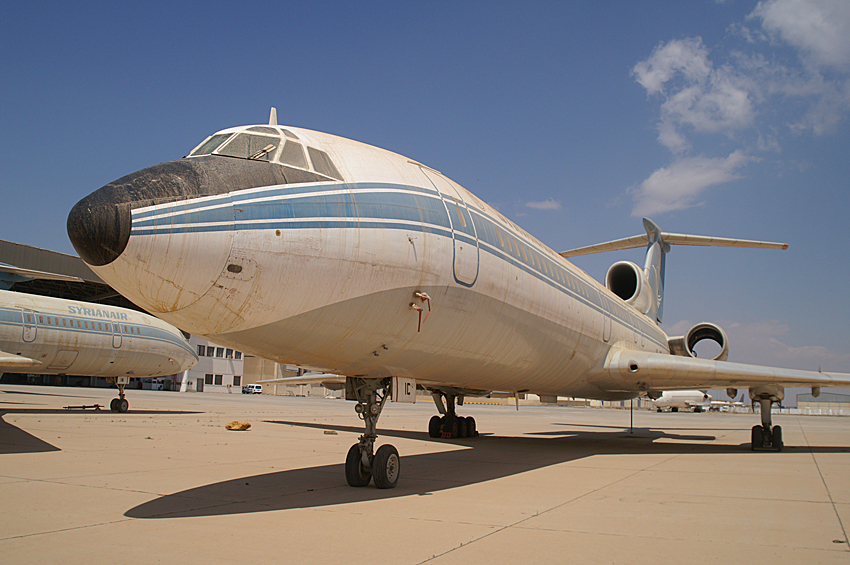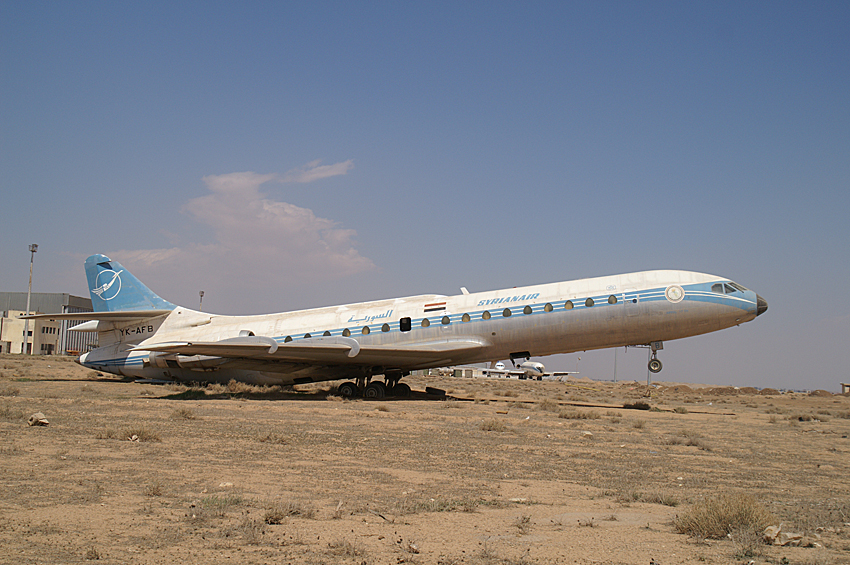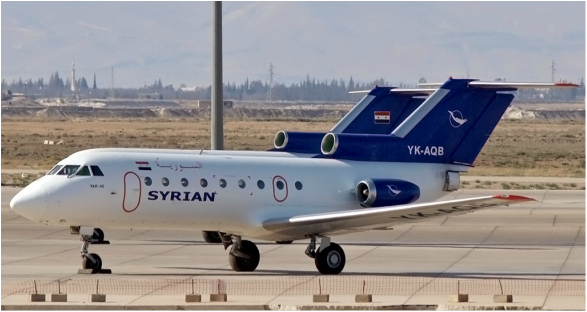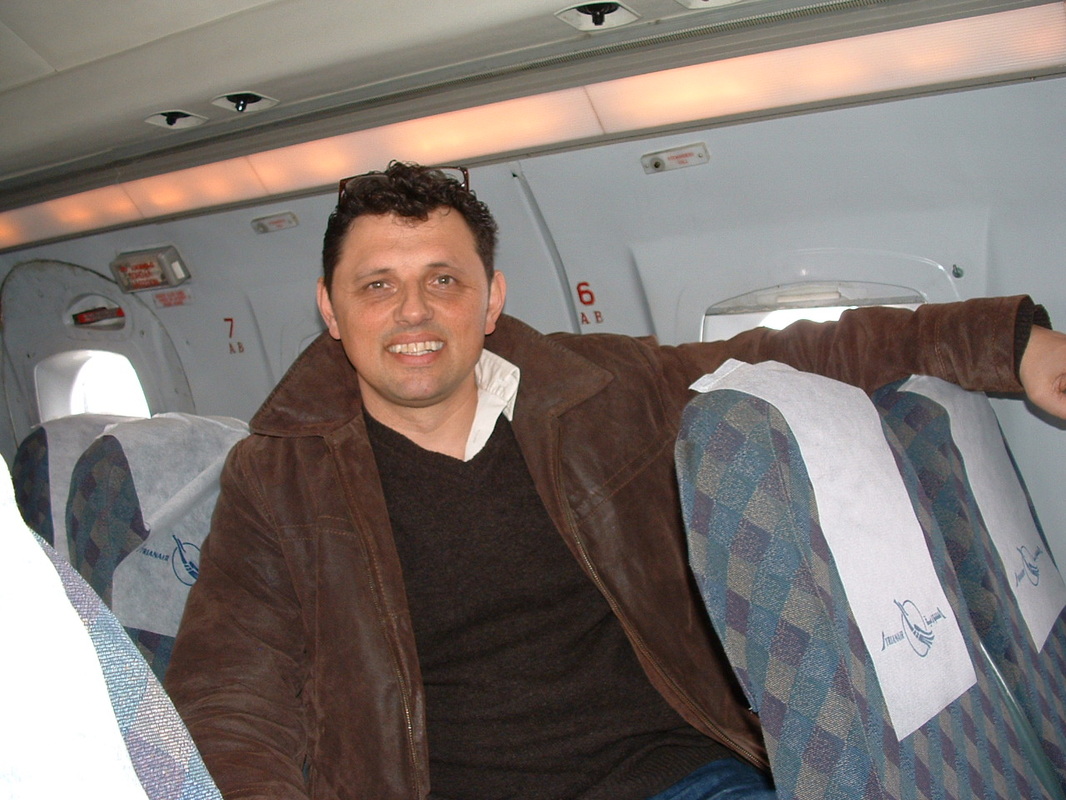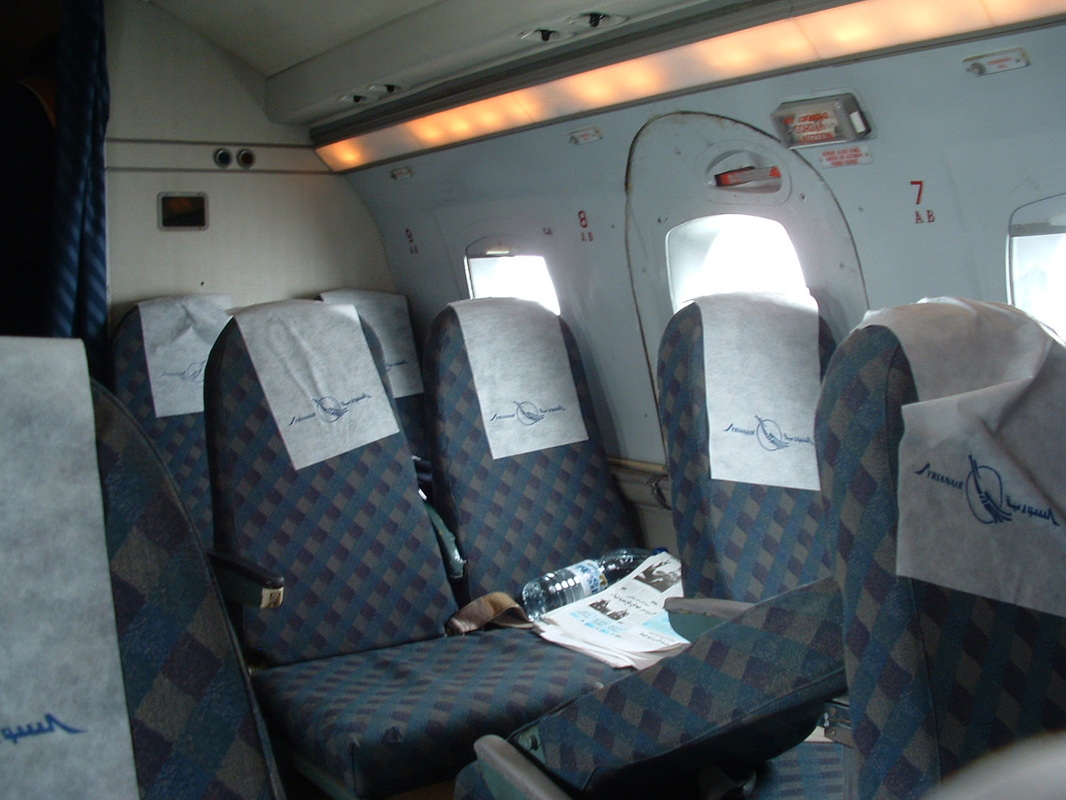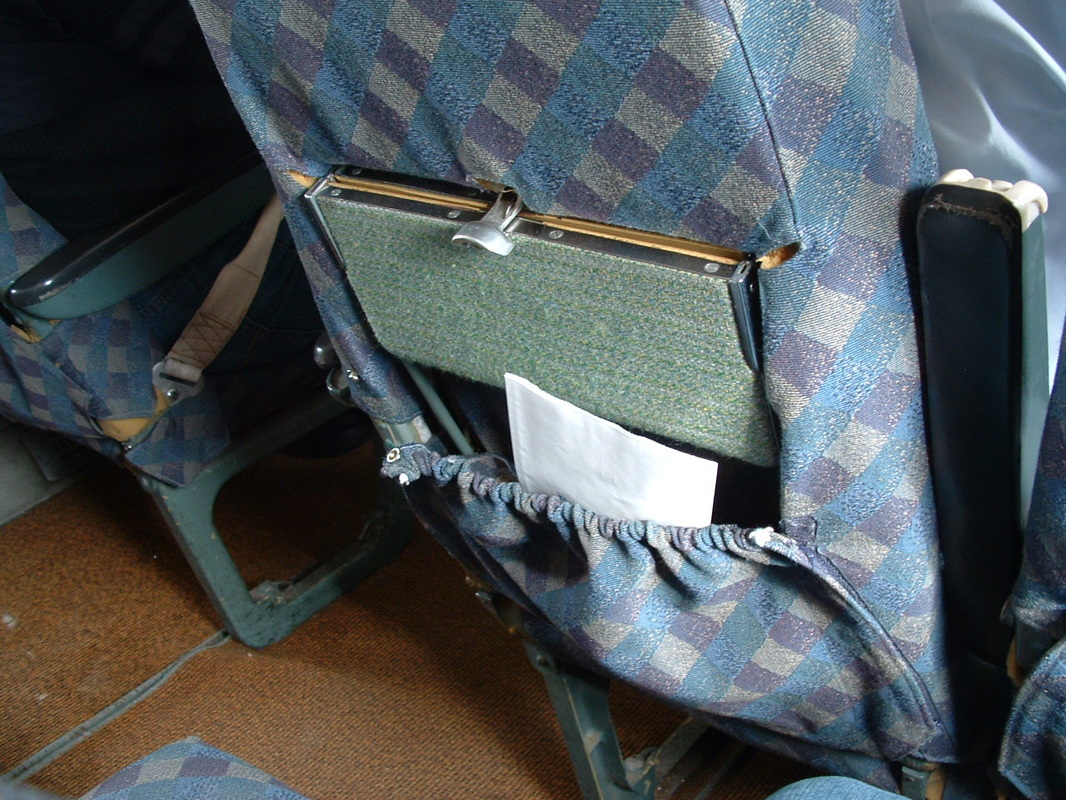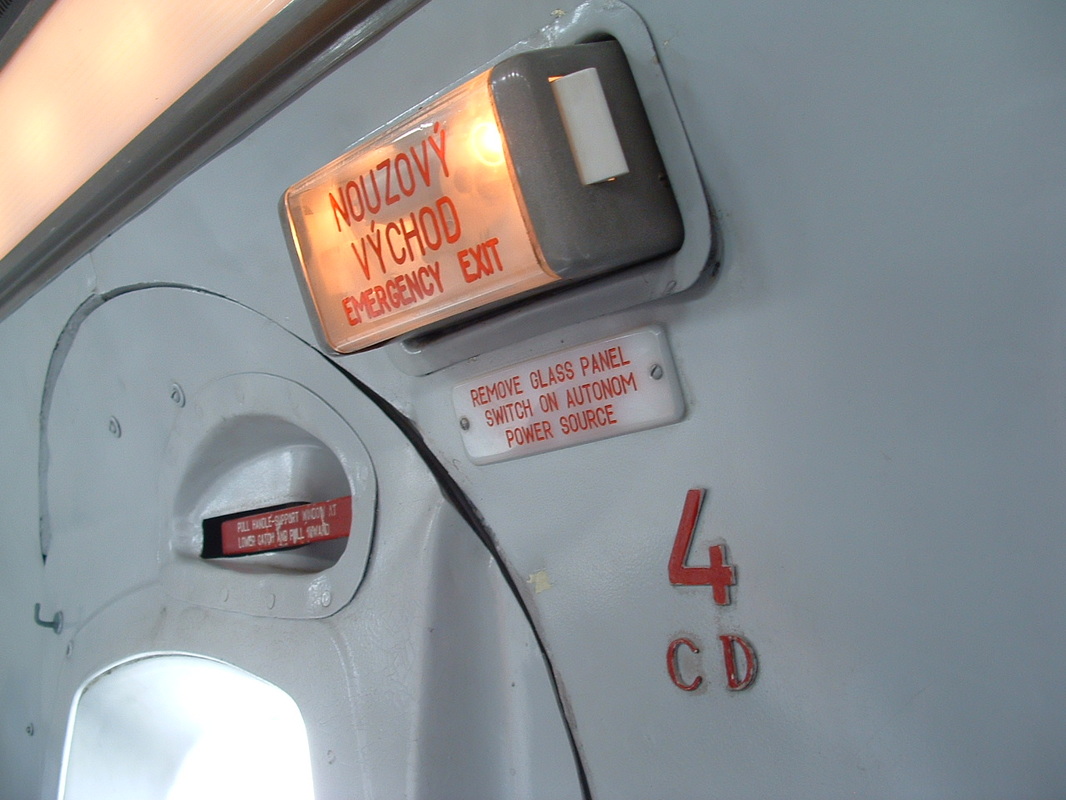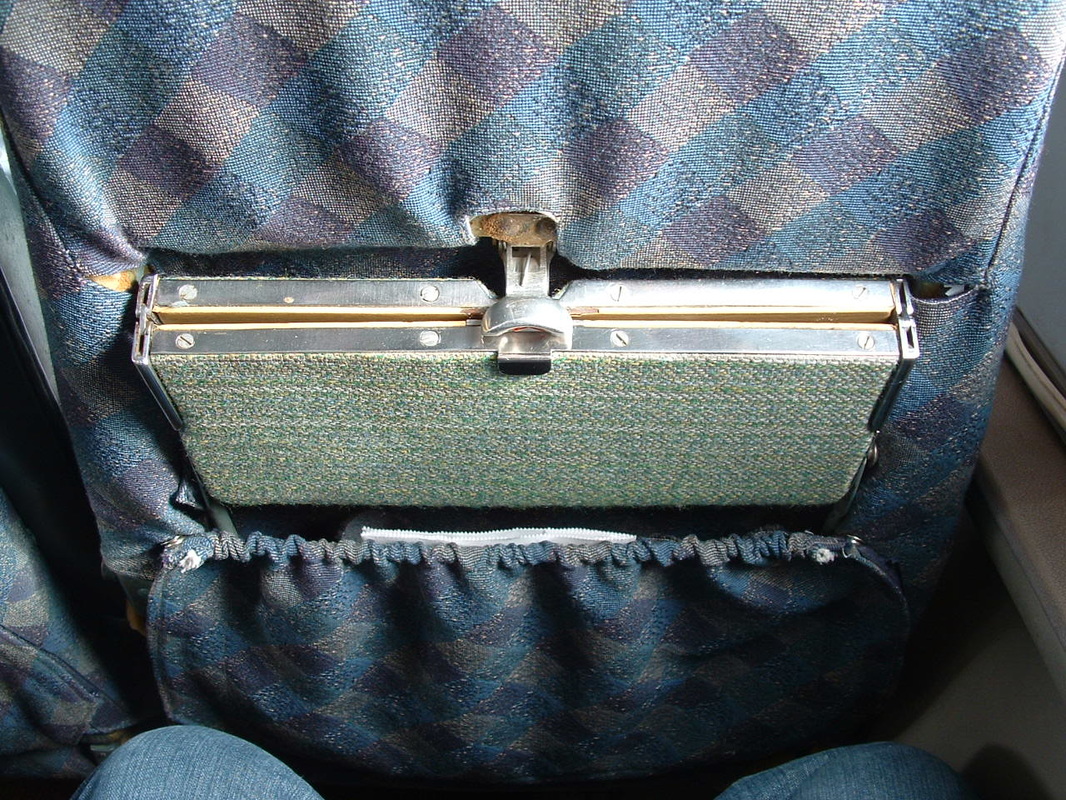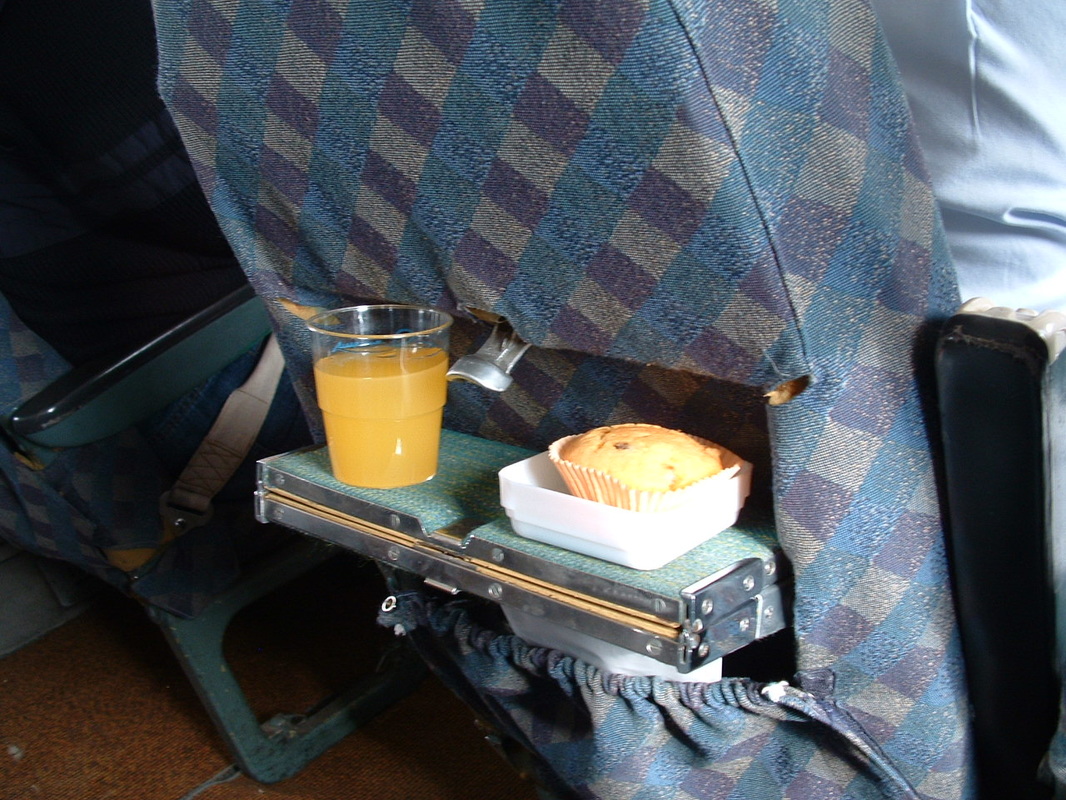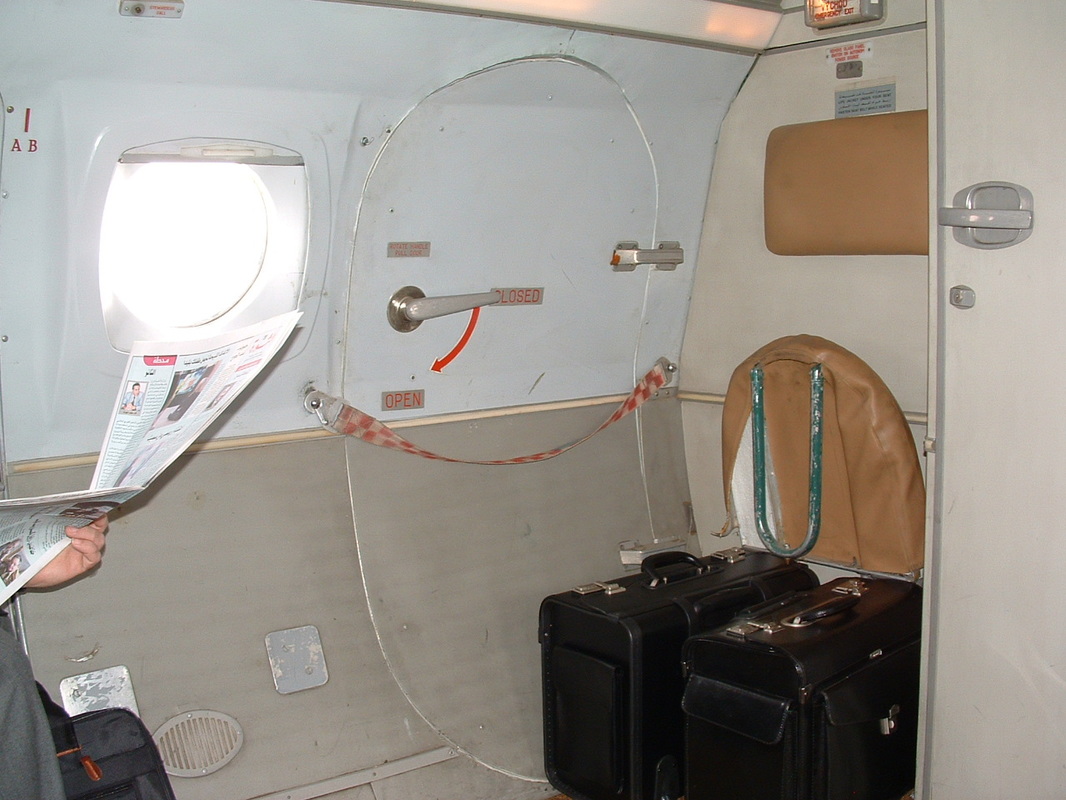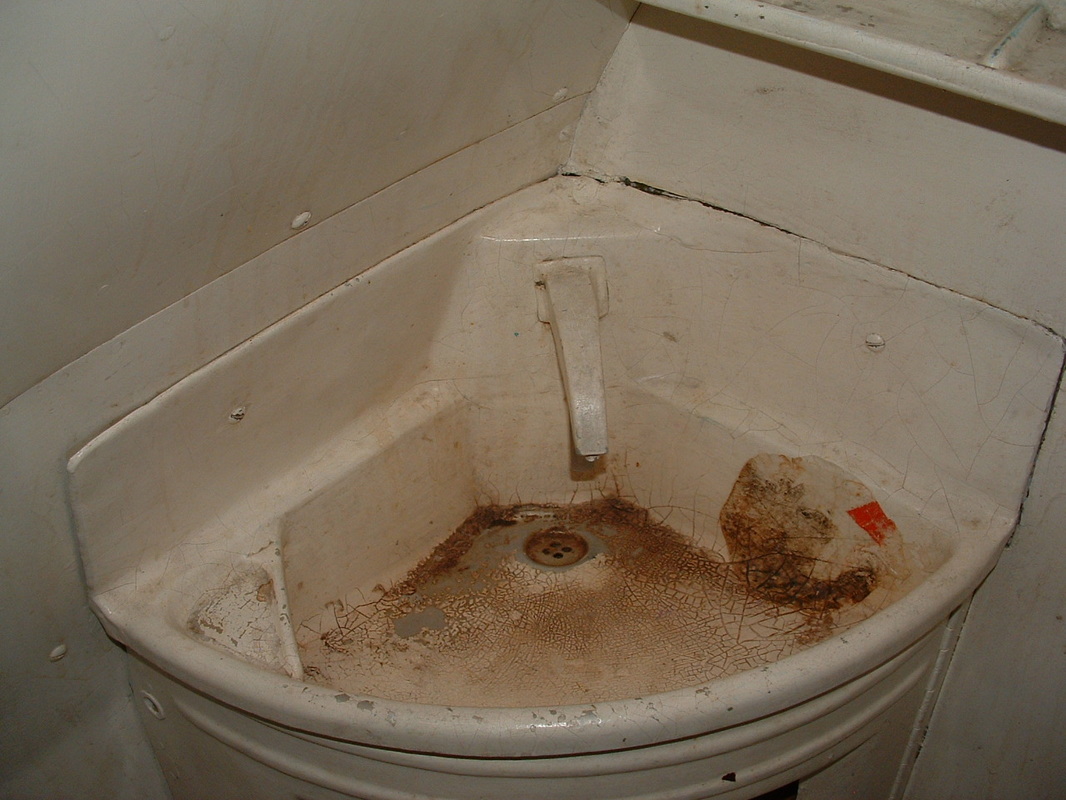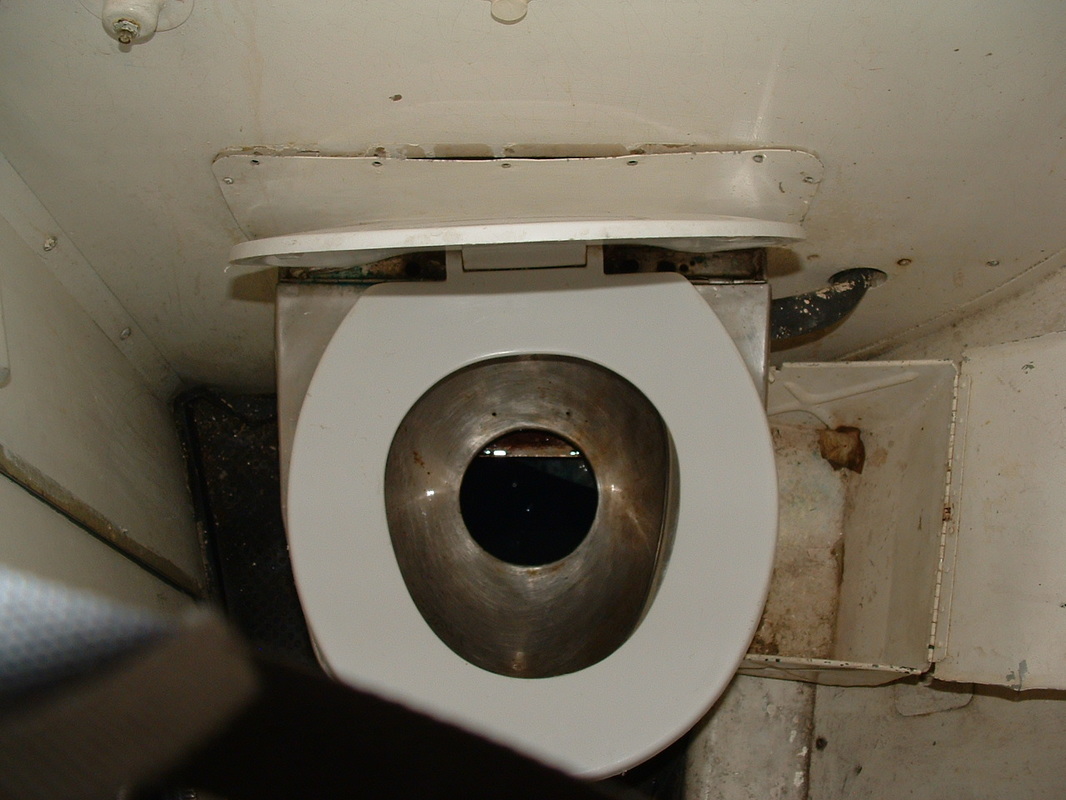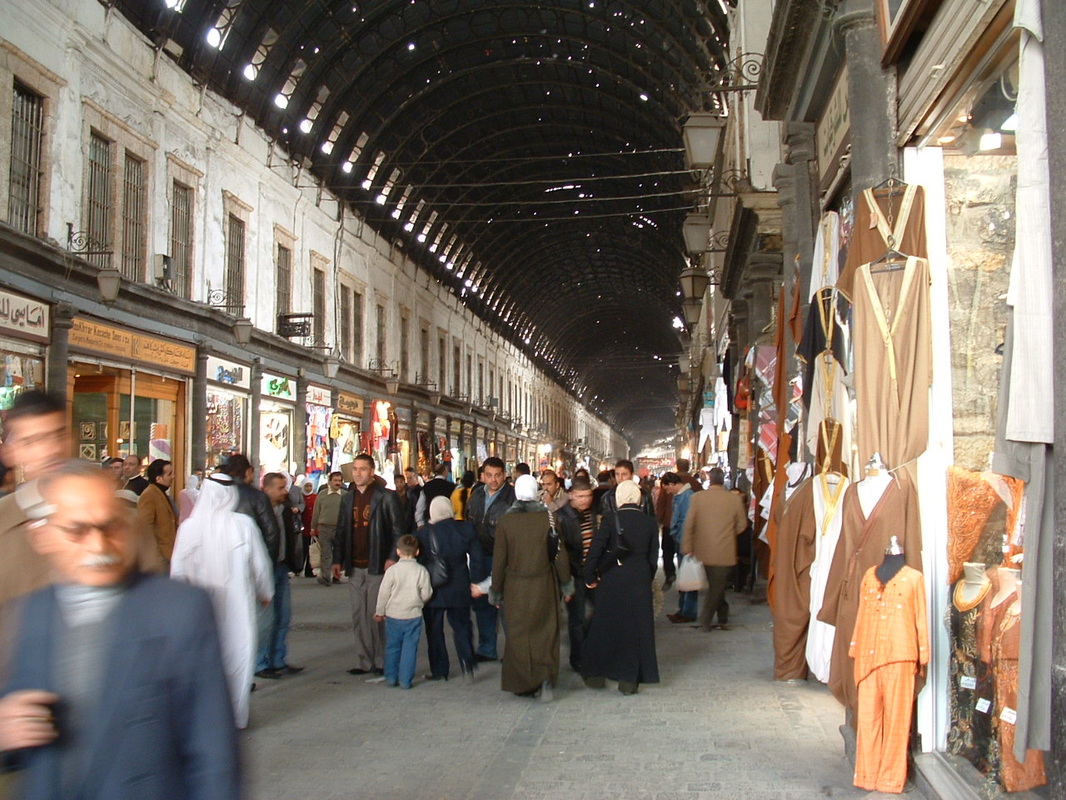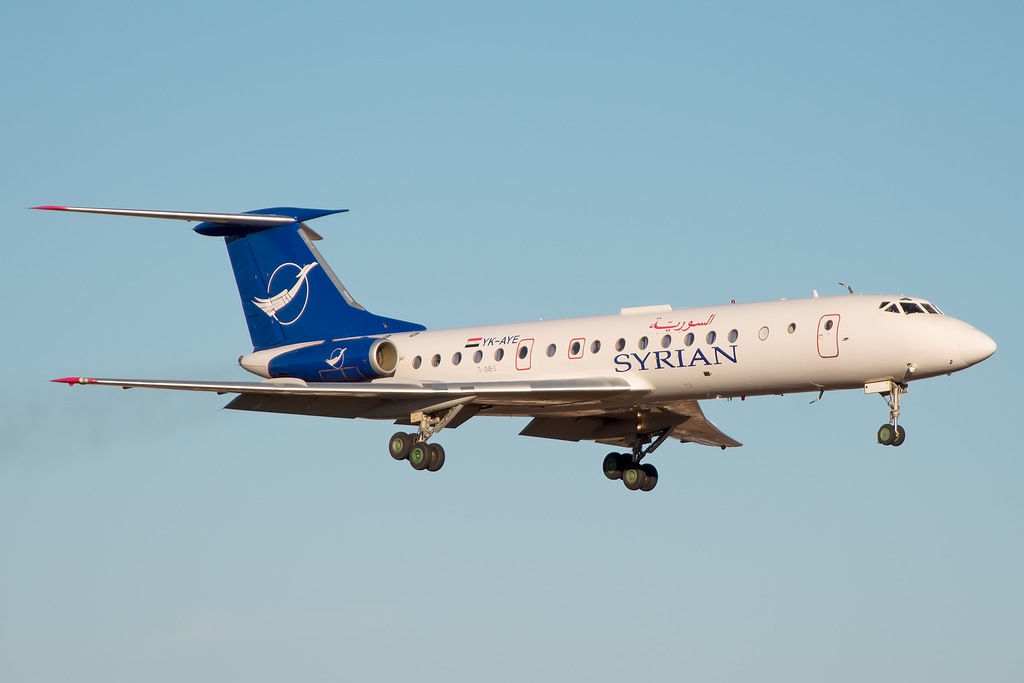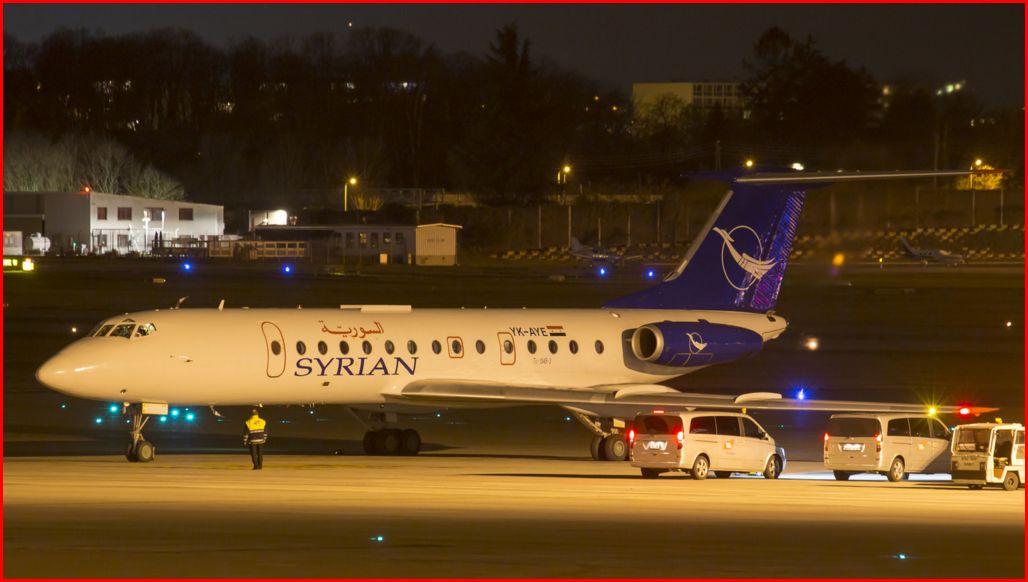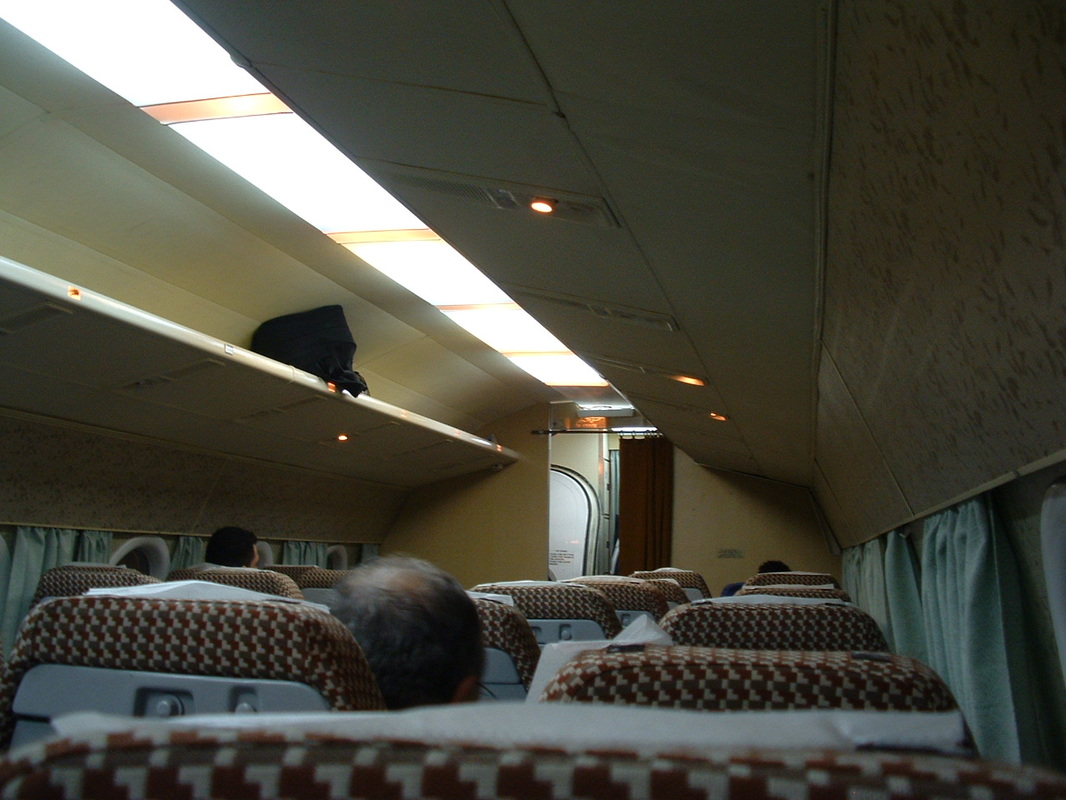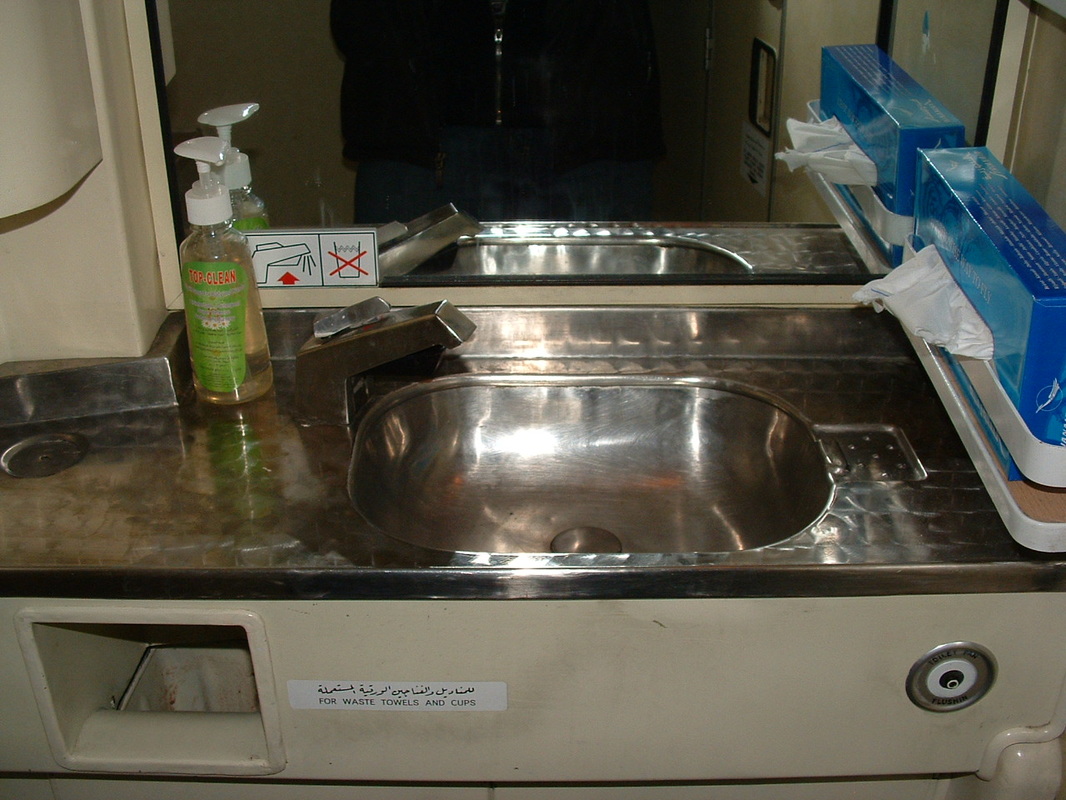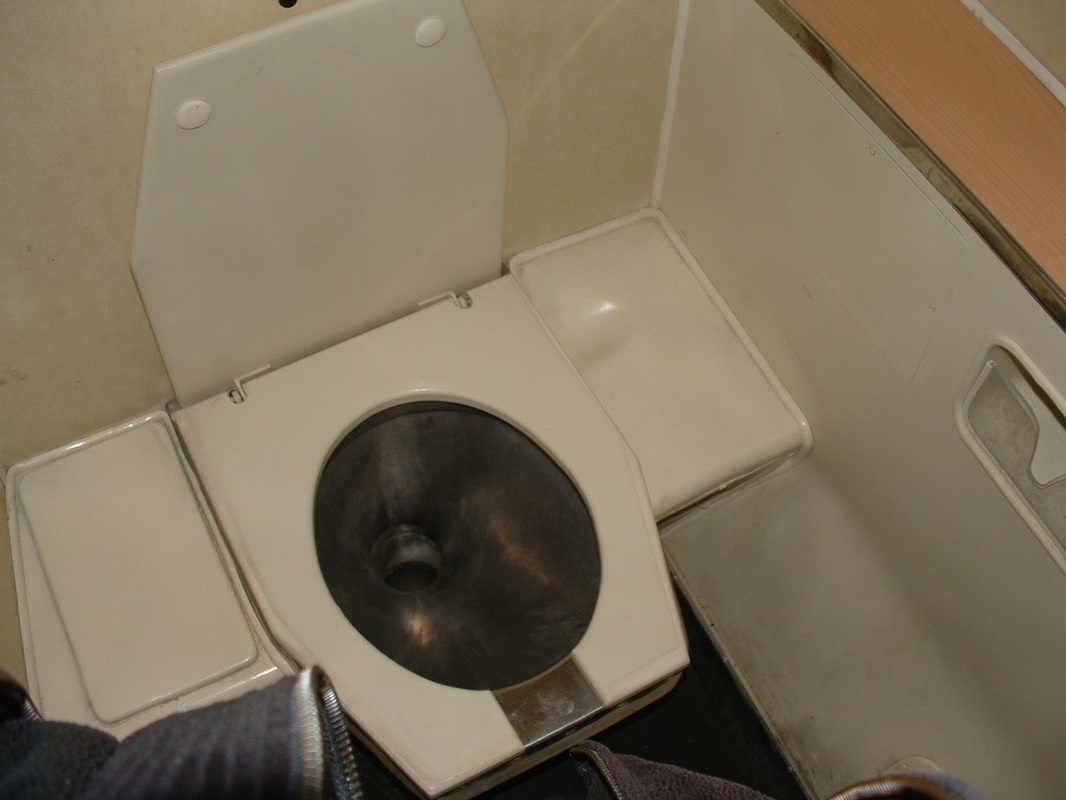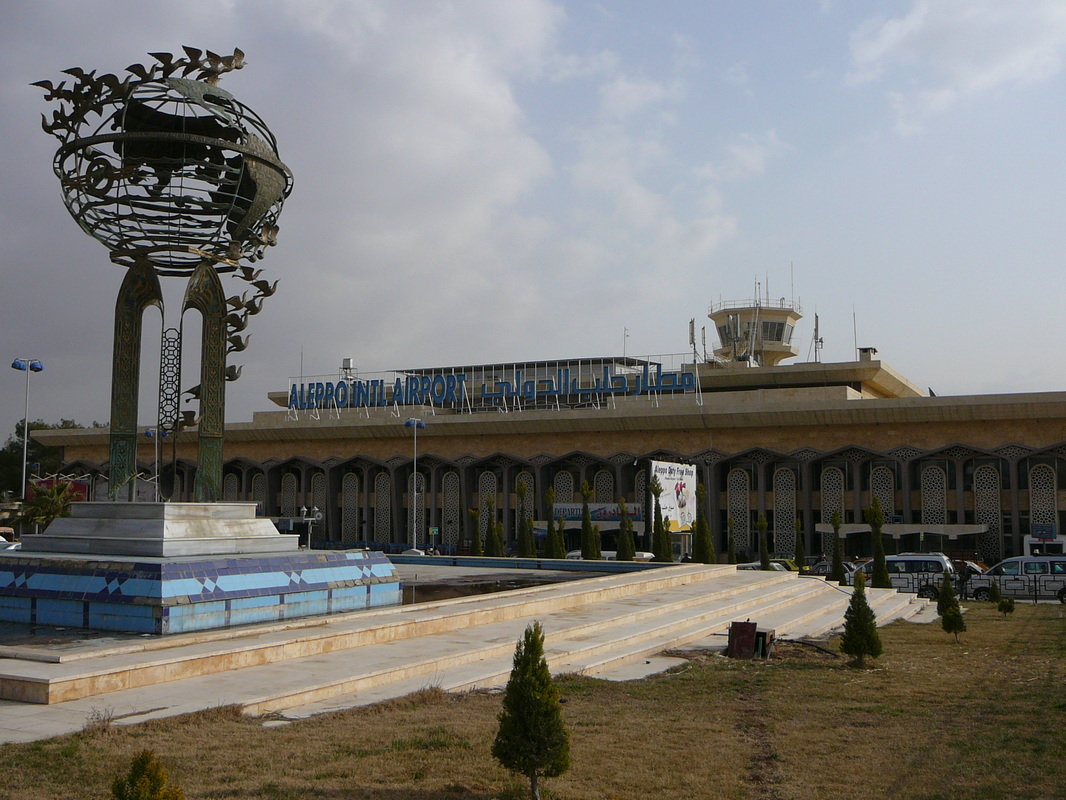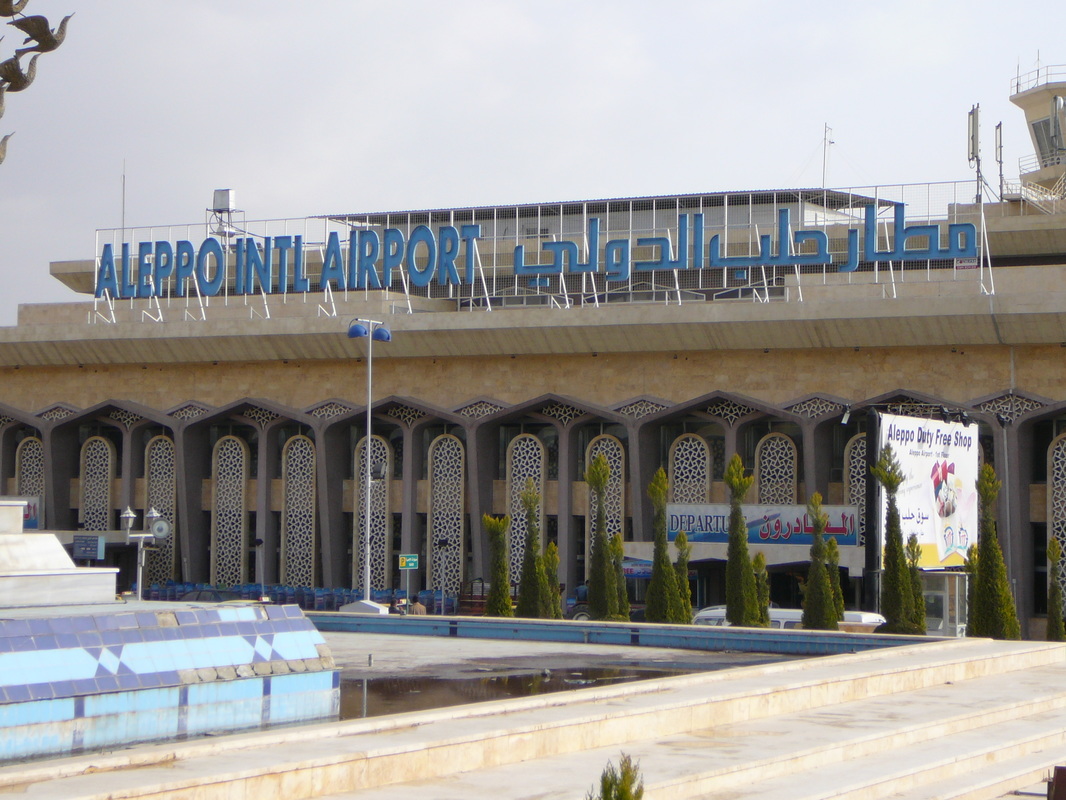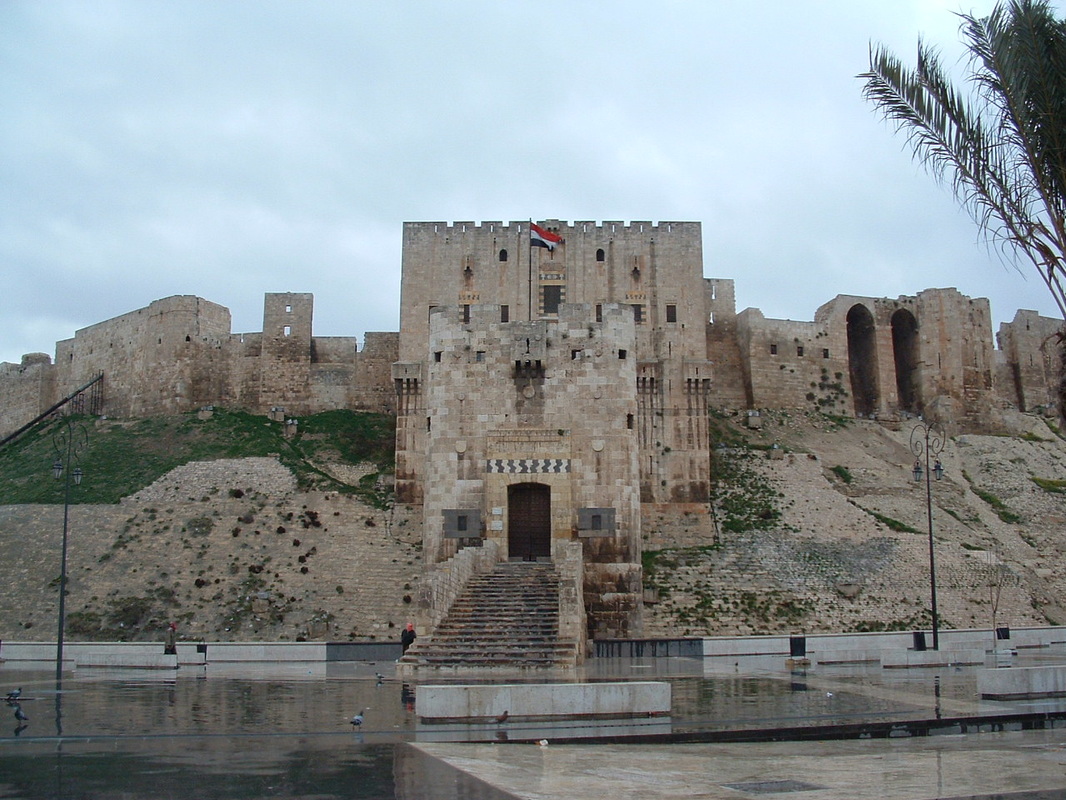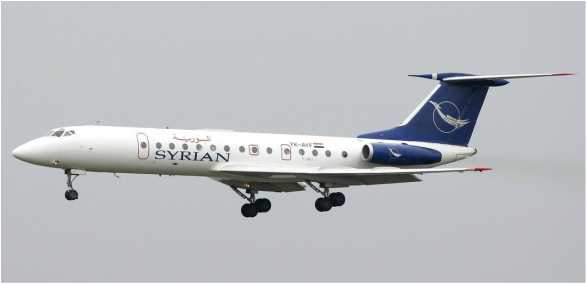Riding Russian Classics in Syrian Skies
By Jan Koppen
(written in Feb. 2008)
|
Axis of Evil
When working at Amsterdam-Schiphol airport, one is always surrounded by modern jets. Once in a while, the need to fly the OldJets must be fulfilled! Nowadays, the choice is limited. Fortunately, Syria is still a land with a good number of second-generation operational jets. At Damascus International Airport, the sky has become not too polluted by the Airbus and Next-Generation Boeing aircraft's modern engines. At DAM, 'screaming' Pratt & Whitney JT8Ds, Solovyev D-30s, and Ivchenko AI-25s of the venerable Boeing 727, 737-200, Tupolev-134, and Yakovlev -40 can still be enjoyed. For us here in comfy Western-Europe, a trip to George W. Bush's 'Axis of Evil' is out of the ordinary, but now and then, such a trip comes up and can offer an experience like no other. Countries like Syria are quickly branded as evil, dangerous, and full of terrorists, but as I had expected to be the case, such a misconception could not have been further from the truth. Its inhabitants are friendly beyond belief, and we felt at ease while wandering around. A bit of English is widely spoken, and some Arabic words from our part did the trick! Allah Akbar During the last week of February, we left Amsterdam onboard Syrianair flight RB427, for the four-hour flight to Damascus. Assigned to our flight was the ten-year-old Airbus 320-200 YK-AKA. Its interior was a bit decrepit, possibly caused by the grueling flight schedule of Syrianair's six Airbus 320s. Nevertheless, we were comfortable and ready to Go! Onboard was also a large group of Dutch Islamic pilgrims on Hadj to Mecca. The men were wearing a white cap, and the ladies of the group were all dressed in black chadors. We left Amsterdam Schiphol Airport from runway 24, with a 30 minutes delay, due to a bit of lubricant leakage from the number one engine. When the sign 'seatbelt on' went off, one of the pilgrims took place in the narrow aisle and started, for the next half an hour, at the top of his voice with Arabic prayers. After each sentence, the whole group responded, thanking Allah Akbar! Syrianair Syrian Arab was established in autumn 1946. In October 1998, Syrianair received its first Airbus A320-232, YK-AKA and a new livery was unveiled for the occasion. Six Airbus A320s were delivered to Syrianair in all, allowing the withdrawal of the outdated Tupolevs from regular service. Fortunenately, for the OldJet enthusiasts these plans were hampered by the reinforcement of a US led embargo against Syria, and the Tu-134s were placed back in service on domestic frequencies to Al-Qamishli (Kameshli) and Aleppo. Presently, Syrianair operates a fleet of 12 aircraft: 6 Airbus A320s, 2 Boeing 727s, 2 Boeing 747SPs and 2 Tupolev Tu-134s, while it continues to use the Syrian Air Force Yakovlev-40s on the twice daily domestic route to Latakia and six a week to Deir ez-Zor. This makes Syrianair the main operator of Soviet built airliners in the region. Most of Syrianair’s flights are multiple leg flights involving a stop in Aleppo, a combination of international destinations with fifth freedom rights, or triangular routings. This route structure comes in sharp contrast to the current practices of European and U.S. airlines, which tend to focus on high-yield, high frequency nonstop flights evolving around a strategic hub. On final approach After almost four hours in-flight, the Mediterranean was sparkling below, while in the distance the north-eastern isthmus of Cyprus was fast approaching. As expected, our flight was slowly drawing to a close and a short announcement from the captain signalled that the descent had begun and that we would be landing in 15 minutes. Flying first over Damascus airport, a tight bank brought us back on track to line up with runway 05R. This provided a wonderful view of the desert below and the Marj Ruhayyil Air Force base with its two 9,500-ft parallel runways. Outside, several hundred feet below us, a bright Syrianair Tupolev-134 went harrowing past, towing needle-like contrails form its shiny tail. She was on final approach and would be landing just some minutes in front of us. After four hours and ten minutes a text-book landing brought an end to our flight. The group of pilgrims thanked Allah once more for his guidance and the safe landing. Later on, we as non-believers, thanked the flight crew during disembarking! While taxing into our assigned parking position we passed, at the end of runway 27L, two stored Tu-134s. Both in the old Syrianair Arab Airways colour scheme and both being in a sorry state. Turning onto the ramp, we also passed two Syrianair Yak-40s, of which one we had planned to fly to Latakia the next morning. As we drawn to a halt the ground staff swung into action quickly and in no time all the passengers were disembarked. The line for the immigration was relatively short, but the hassle and bustle to obtain visa authorisation took some time. Finally we were granted access into Syria. In true Syrian style we flagged down a taxi and 15 minutes later we were deposited at the luxury Elba Cham Palace Airport Hotel. The Syrian Arab Republic or al-Jamhouriya al-Arabiya as-Suriya Following the breakup of the Ottoman Empire during World War I, France administered Syria until its independence in 1946. The country lacked political stability and experienced a series of military coups during its first decades. Syria united with Egypt in February 1958 to form the United Arab Republic. In September 1961, the two entities separated, and the Syrian Arab Republic was re-established. In November 1970, Hafiz al-Assad, a member of the Baath Party and the minority Alawite sect, seized power in a bloodless coup and brought political stability to the country. In the 1967 Arab-Israeli War, Syria lost the Golan Heights to Israel. During the 1990s, Syria and Israel held occasional peace talks over its return. Following the death of President al-Assad, his son, Bashar al-Assad, was approved as president by referendum in July 2000. Syrian troops, stationed in Lebanon since 1976, in an ostensible peacekeeping role, were withdrawn in April 2005. Unfortunately Syria, with a population 15 million soles, remains until today a police state and can be compared to the former DDR. The Assad regime significantly restricts freedom of speech, press, assembly and association, and imposes some limits on freedom of religion and freedom of movement. Also the glorification of president Bashar al-Assad and his late father Hafez is surreal from any perspective. Going to Latakia Our planned Yak-40 flight to Latakia was scheduled to leave Damascus airport at 08.00 hours, so we arranged with the hotel manager for an alarm call at 05.30 hours. After having breakfast in company with a night stopping Air France crew, we ordered a taxi. After a short wrangle, we agreed on the bottom price of $5. The 15km long road to the airport is the show-piece of the country. The wide, curve-less and superb asphalted strip incited our taxi-driver to set a new speed record between Ebla Cham Palace and the airport! As we were approaching the airport the familiar screeching of Pratt & Whitney turbofans became evident. Overhead a stocky Boeing 747SP, with flaps full down came in on final approach. As the ‘Special Performer’ roared by, I spotted the distinguishing dark blue Syrianair crane bird logo adorning its tail fin. For an international airport, Damascus airport is relative small and the arrival and departure hall, in a 1970s-style, are on the same floor. Nevertheless, everything is available; including a Syrianair ticket desk where one can buy domestic tickets at low cost. Central piece in the airport terminal is certainly the oversized billboard with the portrait of the Al-Assad family. It consist of the current President of the Republic and Secretary of the already 45 years ruling Baath Party, Bashar al-Assad, his late father and former ruler of Syria, Hafez al-Assad and his late brother Basil, who died in a car crash in 2000. All three were looking down at us in a stern but paternal manner. The airport was busy, with many flights bound for Middle Eastern and other international destinations. Once it was check-in time for our flight RB115, we proceeded through the one and only gate for the first part of the security charade. We had to unpack our hand luggage several times and show our passports to almost every uniformed official. After all that, we endured a rude and humiliating body search, after which we finally made it to the dilapidated check-in lounge. Our check-in agent turned out to be a good-looking, brown-haired, voluptuous, female dressed in a tight dark-blue Syrianair uniform. With a soft voice, she asked our intentions! Boarding-passes were issued in a professional and efficient manner. After wishing us a pleasant flight, we thanked this Syrian beauty and joined the long line waiting for the immigration inspectors. As we entered the shabby and sweltering hot departure hall, in which a dozen or more billboard pictures of President Bashar al-Assad smiled down at us, a glorious view of the ramp awaited us. An Ilyusihn-76 skimmed over Several OldJets were packed together just in front of the lounge and at that moment, a Syrian Air Force Ilyusihn-76, disguised in the latest Syrianair colours, skimmed over during its takeoff run. With a sharp right hand turn towards the desert, the Ilyushin left a long smoking trail in the crystal blue sky. It seemed that nothing had changed in this location since the 1970s. We felt that we had travelled back in time and I must state that, when compared to the hectic society in which we currently live, this relaxed atmosphere was a nice change. As the war-situation in neighbouring Iraq has calmed down a bit and with more than 1.5 million Iraq refugees between Syrian borders, it is inevitable that fortune-hunters set up an airbrigde between both countries. Several of their transports were packed together in front of the lounge. Consisting of; a neat painted Boeing 737-200 with Cambodian registration XU-RKK. This former Southwest Airlines Boeing is most probably operating for Ishtar Airlines, which is leasing her from Royal Khmer Airlines. Dubai based Ishtar Airlines is established in 2005 by former Iraqi Airways pilots. The company is also operating an anonymous Boeing 727-200 out of Damascus. This former Iberia 727 is wearing the Kenyan registration 5Y-AXE and is leased from African Express Airways. Another operator is the new Syrian start-up Sham Wings Airways, which most probably, also serve the Damascus/Bagdad run. The airline started operations in 2007 and is leasing MD83 SU-BOZ of Egyptian AMC Airlines (Aircraft Maintenance Cairo). Also on the ramp was winglet equipped Boeing 727-76 VP-CJN of the Starling Aviation Company. This 38 years old, ex Trans Australian Airways, short 727 is still looking splendid in her VIP appearance. On the right-hand side of the terminal, several Syrianair aircraft were parked; consisting of two Yakovlev 40s, two Tupolev 134s and a Boeing 727-200. Unfortunately the maintenance hangar of Syrianair is not visible from the terminal, but during the up-coming flights we spotted in front of the company hangar the remaining five Boeing 727-200s of Syrianair. Four of these thirty two year old veterans (YK-AGA, YK-AGC, YK-AGE and YK-AGF) are already several years stored in Syrian Arab Airways colour scheme, and one, YK-AGB, was receiving maintenance inside the hangar and wearing the latest Syrianair colours. Three of the 727s were donated by Kuwait Airways to Syria in 1994, which enabled Syrianair to finally phase out the two Sud-Aviation SE-210-10B3 Caravelles, which it did operate. One of them, YK-AFB, is still present on perimeter of the airport and despite she is sitting on her tail, she still is complete. Also stored for a long time, are Syrianair’s both Tupolev Tu-154M YK-AIA and YK-AIC. The Tupolevs were delivered to the Syrian airline in 1988 and it’s a mystery to me, why they have been taken out of service on their relatively young age? During our visit, Boeing 747SP YK-AHA was parked in a corner at the company’s ramp, with her engines covered to protect her sensitively Pratt & Whitney’s against dust storms. When preparing this article, I noticed that the 747SP isn’t mentioned in Syrianiar’s summer schedule, but I’m convinced, that she still will opertate the lucrative and popular Damascus/Jeddah hadj-route on an ad-hoc basis. Close to the Special Performer stood a former Tunis Air Boeing 727-200, painted in anonymous white, with a dark-blue tail. This Sierra Leone registrated (9L-LDM) trijet, is stored for yet a couple of years, with some external damage to her nose section and was used by the Iraqi Airways for some time. Further afield, on the edge of the military ramp a former Kinshasa Airways Boeing 707-321B 9Q-CWK (ex Pan Am “Clipper Kathay”) is stored for a long time in a reasonable condition. On this wide-spread platform the Syrian Air Force has a lot of aircraft stationed, most of them in Syrianair’s latest colours and all of them in use by the government. I counted five Anotonov-26s, two Yakovlev Yak-40s, Dassault Falcon 20 YK-ASA and YK-ASB, the Falcon 900 YK-ASC, Tupolev Tu-134B-3 YK-AYA and YK-AYB, and four Ilyushins-76 transports (YK-ATB, YK-ATC, YK-ATD), of which one (YK-ATA) was clearly withdrawn from use in the old Syrian Arab colours and parked besides 707 9Q-CWK. As already mentioned, at the end of runway 23L, are Syrianair Tupolev Tu-134s YK-AYC and YK-AYD stored in a dreadful shape and still in the nostalgic old colours scheme of Syrian Arab Airways. Damascus International Airport is, of course, also daily visited by a number of Western european en Middle eastern airlines with present-generation jets. |
|
|
Boarding time
After enjoying the action on the ramp, we ordered an Arab coffee and some delicious, but very sweet pastry at the rather dated terminal-restaurant and went watching the colourful crowd. Passengers in the lounge consisted of well-dressed Syrian businessmen, pilgrims, a handful of Yasser-Arafat look-a-likes and Muslim women dressed in black chadors or more stylish, with headscarf and a long black manteau (overcoat). All of us were constantly observed by many uniformed military and obscure looking Mukhabarat secret police officials. Since I’m a fanatic OldJets photographer, the image of the line-up outside the terminal enticed me to take photos. I requested permission from one of the Mukhabarat agents. He responded with a very surprised and firmly condemned look. Due to the constant political upheavals in the Levant, taking pictures at the airport is the same as signing your own one-way ticket to the notorious Mezze correctional institution. Since this prison system is not yet on western-European comfort level, this should be avoided at all cost! Boarding time for RB115 was announced and after passing a metal detector, a body checker and another hand luggage rummage, we had to show our passports to a sinister-looking character wearing a dark blue leather jacket and impeccable polished shoes. In my sometimes arrogant manner, I asked him who he was and which authority he represented. The man said nothing; he only put his right finger in front of his swollen lips. With everyone in the hall looking at me, with fear in their eyes, I knew I had gone a bit too far. With a friendly and somewhat submissive nod on my part, the atmosphere relaxed. After a few questions and a quick glimpse in my passport, we finally received his permission for entering the boarding-lounge. The more time progressed, more people began to enter the lounge, so we were wondering just how everybody was going to fit onto a single Yak-40. Our question being answered when the Latakia flight was called. Only four, including ourselves boarded the bus for the Latakia flight. According our fellow travellers, the other passengers in the lounge were waiting for the departure of the daily Al-Qamishli flight, which is operated with Syrianair’s Tupolev Tu-134B-3. On our short ride on the ramp we passed Syrianair Boeing 727-200 YK-AGD with its ventral air stair down and apparently being serviced for upcoming flights. YK-AGD is one of the two operational Syrianair 727s and, according the company’s winterschedule, the type is still used on friday morning flight to Aleppo. On a more remote part of the ramp we saw Syrianair Tupolev Tu-134s YK-AYE and YK-AYF brotherly lined-up and one of them being fuelled and catered. Most certainly to operate the Al-Qamishli flight. YK-AQE Far too quick we arrived at the two parked Yakovlev Yak-40s. One of them appeared to be YK-AQB, adorned with an oversized photo-sticker of the almighty president Bashar-Al-Assad on its flank. The other one was YK-AQE, one of Syrianair Yak-40K’s, and assigned for our flight. The type went into production in the mid-sixties until 1978. 1011 were built by the Saratov aircraft factory, of which several were exported to Syria. The Yak-40’s most noticeable design feature is its trijet configuration, with three Ivchenko AI-25 two shaft turbofans. The three jet engine layout was chosen for increased redundancy and hence better one engine out performance, allowing good short field performance. The unswept, high aspect ratio wing was also designed for good field performance. An onboard auxiliary power unit and a ventral air stair in the rear fuselage allow autonomous operation at remote airfields. A high power-to-weight ratio allows the Yak-40 a good hot-and-high performance. Operating economics was a lesser priority and one of its nicknames is “kerosene exterminator” due to its low fuel efficiency. The small Jet is 6.5 meter tall, with a wing span of 25 meter and a length of 20.36 meter. Economical cruising speed is 470km/hour and its range, with max payload of 32 passengers, is 1450 kilometres. The empty weight of the trijet is a mere 9,400kg and its take-off weight 16,000kg. The small, three-engine airliner is often called the first regional jet transport, long before we in the West got acquainted with City liners and Regional Jets and remained basically unchanged during its production life. A number of developments were proposed, including the Yak-40K. This is the cargo-passenger version, with a maximum payload of 3200kg and in use with Syrianair. Apart from airliner use by Syrianair, the Syrian Air Force has a number of Yak-40’s in service as governmental transport. Not exactly mother’s finest On the ground, our Yak was quite an ugly little monster, with a sleek nose and straight wings ruined by a retractable tricycle landing gear with big ballon tyres. Its fuselage, rear-mounted engines and tail showed lots of wear as strong dirt effects contracted against the sleek blue Syrianair livery. Mechanics were climbing ladders, checking for leaks and doing inspections, as a faint smell of Jet-A1 fuel permeateaded around the little Jet. We boarded the Yak-40 from the rear via the ventral air stair, like its big brother the Yak-42. The cabin though is a lot, lot smaller and it was freezing cold inside. In the aft is the luggage compartment, wardrobe, lavatory and a very small buffet. Inside the 30-year-old jet, the cabin was all I expected, and more – sporting the much hoped for original hat-rack interior on one side of the cabin. Under these open overhead racks sported, 1970s style PSUs, including a waitress call button and a simple but effective peg. The craft had four emergency exits. Strangely enough with ‘nouzovẏ vẏchod’ markings (emergency exit) in Czech. Up front was a folding chair for the cabin attendant and on the left-hand side the cargo-door. The interior was a bit decrepit. The camel colourful carpet on the floor was filthy and frayed, and most of the windows were cracked and faded. Syrianair is operating its Yak-40 in a high density, four abreast configuration, allowing a maximum seating for 32 passengers. The seats, which could fall flat, were very interesting, especially the tray table in the back. Due to the sorry state of the interior we were not surprised that we could not get the folding tables back into their stowed position. The crew for our flight comprised of a Captain, a Co-pilot, one Flight-engineer, two males- and one female cabin attendant, one mukharabad agent and one mechanic. It seemed to me, compared to the traffic load of only four persons, a bit overdone. The mechanic, who was sitting next to me appeared to be a nice chap and supplied us with many interesting information about our flight and the Yak-40. The Ivchenko’s violently roared There was no cabin announcement, so the first inkling of our departure was when the three Ivchenko AI-25 turbofans came alive. We strapped in and with a sudden roar, the engines increased power for forward momentum. The crew carefully eased their airplane away from its stand as we taxied to the active taxiway. As the little jetliner rolled along the concrete, her wings were flexing slightly form ground shocks and I felt the wheels transmit the vibration of tar strips over concrete. Takeoff would be on the heading of 230 degrees. The wind was from the southwest, a breeze drifted gently across the airport at two-knots and the temperature needle stood at an even 10 degrees Celsius. After passing the two stored Syrian Arab Tupolev’s and following a Jazeera A320, we finally reached the holding point for runway 23L. The nose wheel rolled onto the runway and ahead lay over 12,000-ft of concrete. Suddenly the noise rose to a furious level, as the Yak-40’s three 14.7kN Ivchenko AI-25 turbofans violently roared. With the engines screaming we started to accelerate. Using only a short part of runway 23L length, our miniature Jet lifted casually into the air, leaving a large corkscrew of smoke spiralling away behind us. Despite her powerful engines with their rather scary fuel consumption (on the sector DAM/LTK alone, our small jet would burn over 1,000kg of fuel), the Yak-40 will never win awards for climb, due to her little wings. With a shallow left hand turn, over the desert, we commenced the flight up to Latakia, a large city on the coast of the Mediterranean and Syria’s most important port. Although there was no safety instruction, the brief welcome in Arabic and broken English by the flight deck, who, by the way, estimated the flight time a mere 50 hours (?!?), was appreciated. In our climb to 28,000-ft to Lebor intersection, our trijet proceeded northbound towards Qattina Lake near the city of Homs. As soon as we were at our initial cruise altitude the passengers and cabin crew began to mill around and socialize. The outdated Ivchenko’s certainly producing some noise, especially in the aft of the cabin and in the very cramp and filthy lavatory. The female attendant turned out to be a Miss World look-a-like and she was dressed in Syrianair’s charming cabin attend uniform. In-flight service was limited to a dried-up muffin, a coffee and an Arabic newspaper. Of course, no in-flight magazines onboard this semi-military flight and also no safety feature cards were present in the pockets of the weary seats. During the flight, my friend was surprisingly allowed, by our gruffy mukharabad agent, to take some pictures of the interior, but a visit to the cockpit was turned down flat. From Lebor waypoint we headed 331 degrees to Latakia’s, martyr Bassil Al-Assad airport. Around 35 minutes after lifting off from Damascus the descent into Latakia began, while we passed the snow capped Alawite Mountains below us. Soon the coastal port city of Banias, glinting in the morning light, appeared on the horizon. The Ivchenko’s went quiet and the whispering roar of the slipstream followed the Yak-40 down to 8000-ft for the inbound turn. The old girl shuddered and dipped as ‘AQE’ descended into a gray layer of wispy clouds. Droplets of condensation formed on the windows, briefly obscuring my view. The seatbelt light came on and we were told that we were descending toward the airstrip. In a few moments we would be landing at Latakia. At least, so we thought. We were able to hear the whine of the engines as the throttles were advanced and decreased, to counteract the now heavy turbulence. The wings flexed fiercely and airflow sound changed constantly, as the ‘Yak’ jerked and lurched its way through the bumps. Suddenly, I felt the nose pitched up and it seemed that we passed over Latakia. Then the bad news began to filter through, there was far too much crosswind over Latakia’s runway and we were being diverted back to Damascus. |
|
|
Back to Damascus
After half an hour Damascus airport appeared in the distance and we hovered overhead at 09.42 hours. Down below, on the military platform, we saw a chunky Syrian Air Force Iluyshin-76 taxing towards to active runway. The descent towards runway 05R was signalled by the hushing of the engines. After a long approach, we came across the threshold at high speed and the pilot performed a perfect, but very fast touchdown just past the numbers. We literally couldn’t feel the wheels touch down. After flaring the nose lowered and behind me the rumble of the central engine’s reverse thrust could be heard. We used up less than half the runway and while we vacated the runway, we could just see how departing sister ship YK-AQG was gathering speed while she was racing along the runway, on her way to Deir ez-Zor. We taxied into our assigned parking spot next to the still idle YK-AQB. When the engines spooled down, the pilot appeared in the cabin, profusely apologizing for the slip-up, but ‘safety first’ is the credo of Syrianair. We of course agreed and according to us, the crew did an outstanding job, which is a credit to Syrianair long-standing safe operations. Keep in mind, the last serious incident in which a Syrianair aircraft was involved dates back to February 06, 1967 when Douglas DC-3 YK-ACB crash landed at Aleppo! A safety record, of which most flag-carriers would be proud of. We gathered our personal items and disembarked through the ventral air stair and being bussed back into terminal to collect a miraculous refund. Instead of money we got a beautiful Syrianair calendar! Damascus city As our plans were unexpectly changed, we had a R&R afternoon in Damascus. The city is a crowded metropolis of 4 million people and is the chief manufacturing and trading centre of Syria. Most of the main sites of interest are found in or near the Old City. In 1516 an Ottoman army captured Damascus and for the next 400 years the city was a part of the Ottoman Empire. On October 1st, 1918 Allied troops entered the city and Turkish domination came to an end. The French, who were given the UN mandate over Syria, finally left in the spring of 1946 and Damascus became the capital of the Syrian Republic. The main attraction is Souq Hamidiye. This is a fascinating area of covered souks, running through a maze of narrow, twisting streets, under an iron roof. Also do not miss to visit the splendid and opulent Great Omayyad Mosque and the Hedjaz railway station-lounge, where the locals enjoy their Arabic coffee and a narghile (water-pipe). |
|
|
Andrei Nikolaevich Tupolev, the father of Russian aviation
The Tupolev design bureau was responsible for development of the Tu-134 with its rear fuselage mounted engines and a T-tail. Design curiosities of the Tu-134 included a sharp wing sweepback of 35 degrees, compared to 28-28 degrees in its Western analogues. Her wing span is 29 meter, length 37.05 meter and height 9.14 meter. The flight deck is occupied by three flight crew members, comprising two pilots and a flight-engineer. Commercial services were launched by Aeroflot in 1967 and for many years the Tu-134, with its fuselage diameter of 2.9 meter, was the standard short haul jet airliner in the Soviet Union and Eastern Europe. A total of 852 Tu-134s were build, with approximately 170 exported to various east European airlines and other Soviet client states such as Syria. Seating up to 76 in a single class, the Tu-134A differed from the Tu-134 in having a 2.10m fuselage stretch, a reprofiled solid nose, more powerful low-bypass turbofan Solovyev D30 engines and an APU. These upgraded D-30 engines featured thrust reversers. Other versions are the Tu-134B, which has a revised interior. The range of the Tupolev with 5000kg payload is around 3000km. Operating empty weight for the Tu-134B-3 is around 30,000kg and the max take-off weight is 49,000kg. With the introduction of new ICAO noise regulations, the Tu-134, with its loud Solovyev engines, dating back to the 1960s, has been effectively banned from much of European airspace several years ago and replaced with modern technology aircraft. Fortunately, the type is still providing yeoman service in Russia and other Tupolev client’s states, but also in these countries the number of Tu-134s in active service are decreasing rapidly, mainly due to high fuel and maintenance costs. We boarded a Russian sub We boarded the ‘Tup’, via the submarine style door opening and we were invited by the friendly pilot to visit his impeccable but cramp cockpit. The flight deck was much as it has appeared in the eighties when the aircraft was built, with the exception of the addition of a GPS navigation system. The full array of its old fashion black coloured avionics and shiny taps and levers on a green panel, gave the impression that we just had boarded a Russian submarine! We thanked the flight-crew for their hospitality and we shuffled through the forward galley into the cabin. Meanwhile outside, the refuelling truck drove away and the ground crew was in a final process of prepping our Jet for her airborne venture. Seated in the back row, where the engine sound is at its loudest, is the ultimate onboard experience of flying on this classic Russian short-haul jetliner. From there we also had a perfect survey of the cosy, 1970s styled cabin. Except of the light-blue dirty carpet on the floor, the overall condition of the cabin was good. The beige sidewalls were decorated with a light-brown floral leaf design. In the ceiling were yellowed light-troughs, with old fashion strip light, which ran the full length of the roof. The original hat-rack interior was still in place and under it sported, hard plastic personal service units. The emergency exits doors, with their Arabic and English writing, had a build-in live-saving rope available. The windows were in good shape without scratches or being faded. Small turquoise curtains gave the cabin a homey feeling. The red-brown seats were a bit worn-out but Syrianair has only 76 single class seats in their ‘Tup’s’, which gave us plenty leg space. As the remaining passengers were streaming into the cabin, I soaked up the atmosphere of this old-fashion airliner as much as possible. The Tupolev Tu-134 still has a bit of nostalgic-travel feel about it, while the today’s next generation Jets tend to be all metal tubes, full of seats and efficiency! The thundering Jet rushes upwards into the aIR Outside the craft, the ground staff worked with the crew. Through the still open cockpit door we could see them preparing for engine start up. With the forward ramp stair dragged away and doors sealed, the Jet was cleared by the ground crew for engine start. At the same time, the ground power unit, which was already connected to the aft intake, and responsible for the pressurized air, changed its low hum brutally into a high-pitched racket. Slowly, the engines started to suck massive quantities of air through their intakes in order to maintain the necessary thrust. Quickly, both Solovyev’s were whistling away in their familiar high-pitched howl. With a resolute “thumbs up” signal, the ground crew indicated that everything was OK and that the Tupolev was ready to roll. Simultaneously, and with a sudden roar, the two powerful low-bypass turbofans increased power for forward momentum. The ‘134’ stirred itself, the silver swept-back wings swaying, as she began to roll onto the taxiway. After a lengthy taxi, which leaded us through a maze of blue and green ground lights, and in which the safety briefing was given in Arabic and unintelligible English, we finally, reached the holding point for runway 23L at 04.10 hours. Ahead lay over 11,000 feet of concrete. After a lengthy wait, we were cleared for takeoff and the two powerful, high-hour, Solovyev D30-IIIs turbofans were pushed to maximum thrust. The nose bobbed up as the brakes were released and the jet responded instantly to the demands of the engines. We were pressed into our seats as she surged forward and we were treated on real, rumble and scream engine sound. With a low load of only 18 passengers, our sleek Tupolev gathered speed quickly as we chased off down the runway. At an impressive rate of acceleration, she was powering skywards in a steep climb, like a scrambling Lockheed F-104G Starfighter. Seconds later, we felt the massive gear retracting into the bulbous canoe bearings. The crew also retracted the flaps and with a sharp left turn, our aerodynamically clean Tupolev crossed nearby Marj Ruhayyil Airbase. In her initial climb she quickly tracked northbound for the Kariatain reporting point. The smoke-trailing Solovyev’s, howled with the combined thrust of 123,4 kN as we thundered through the night. Economical cruising speed was 750km/hour and the operating ceiling for this short 55 minute hop was only 26,000-ft. In-flight service for this night flight was limited to the already well-known muffin and a coffee. During the flight I got acquainted with a distinguished, white haired, middle aged man. He introdroduced himself as; - “ein atom forscher aus ehemalig Karl-Marx stadt, DDR”. As a nuclear scientist, he did observed things others would not take into calculation. According him, there was a milli-second of power dip in the TL-lights above us when the anti-collision light flashed. I thought his was kidding, but when I checked the red flash of the anti-collision-light, lighted up the characteristic vortex generator, on top of the wing, I could confirm his observation. When visiting the ‘restroom’ , which was a far cry from the cramp and filthy lavatory of the Yak-40, I noticed another characteristic feature of the ‘Tup’, I could peer out into the star filled night, as there’s a window above one’s head! Strap in folks We’d had no descent message from the pilot, but when the engines (which are right next to the toilet) went quiet and the whispering roar of the slipstream followed, I suspected something was happening and I returned to my seat. As we approached Aleppo, preparation was made for the final descent and we were able to hear the whine of the engine as the throttles were advanced to counteract the drag of the flaps. At base-leg I got the runway inside, and it lay like a night-time boulevard in an oil well, brightly lit by emergency white intensity incandescent. ‘AYF’ lumbered down slightly off-set final towards the threshold of runway 27 and shortly afterwards, the jet’s landing gear was lowered causing the noise level in the cabin to increase as the units disturbed the airflow. The approach was breathtaking as the jet streaked low over several brightly lit minarets. At the last moment the threshold light flickered beneath the fuselage and the cabin was lit by rushing flashes and racing shadows. It seemed there was silence in those last moments and I waited, counting, waiting for the bogies to touch and rumble. The aircraft bounced heavily twice, staying airborne momentarily each time, before making more permanent contact. Finally we were down and roaring along the runway. Spoilers were deployed and the two Solovyev’s engines, which provided a truly magnificent flight experience, went into full reverse. Bellowing and howling we tore down the bumpy runway. Brakes were applied and the plane hunched down, crouching on the tarmac as she sped along. ‘AYF’ slowed gradually at first and finally rolled to a halt. Gingerly a ramp agent guided RB121 onto its assigned hardstand position and so ended, at 05.05 hours, another “routine” Syrianair Tupolev Tu-134 flight. The flight was most impressive which is a credit to Syrianair’s longstanding Tupolev Tu-134 operations. We gathered our personal items and disembarked through the forward air stair and were bussed to the nearby terminal. |
|
|
Aleppo
Said to have been built over 5,000 years ago, Aleppo is Syria’s second largest city. The most impressive sight for visitors is the colossal Citadel of Aleppo, which dominates the entire city. The main attraction is the fascinating area of covered souks. A maze of narrow, twisting street, reaching 7km in length, under a vaulted, stone roof. Absolutely everything is sold here, from spices, to meat to prayer-mats. Do also not miss a visit to the Grand Mosque which dates from the 11th century. |
|
|
Back to Damascus
That evening we returned to Damascus, again onboard our faithful Tupolev YK-AYF, in order to catch our homebound flight RB427 to Amsterdam, with intermediate stops at Aleppo and Brussels. Syrianair stands at a crossroads today; its future and prosperity will depend on whether it will rise the challenge of relinquishing its old business methods in favour of more modern, cost-effective and consumer friendly strategies. On the other hand, for the OldJet aviation enthusiast, there’s still an opportunity to ride second-generation jet aircraft. We had travelled aboard two russian classics and enjoyed it very much. Nobody knows when Syrianair will retire her vintage jets from service. So if you want to fly one or two of them, now is the time – otherwise you may miss out on a very enjoyable experience. For the OldJets of Syrianair, its business as usual. Another turnaround, another crew, another varied selection of passengers and another journey. I would like to thank Steven Kinder, Kevin Greenwood, Olivier Lamoral and Pieter Alderden for their contributions to this article. |
|
|
|
Hier klikken om te bewerken.
|
